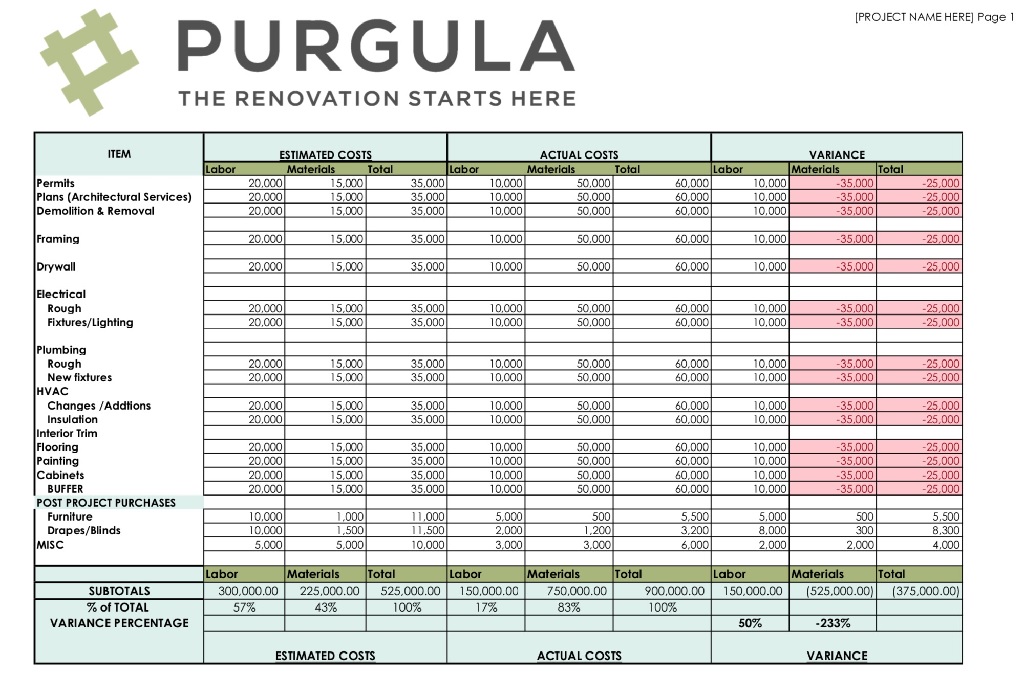Updated September 28, 2022
Creating a realistic renovation budget and managing expenses for your project is an imperative strategy to prevent or mitigate cost overruns. By planning upfront and consistently monitoring costs throughout the duration of your project, you can substantially minimize financial surprises and setbacks throughout the process.
Here are five tips to guide you through the budgeting phase for major renovation projects.
5 Steps to Plan Your Renovation Budget
- Plan Every Detail Upfront
- Lock Down Key Features & Defend Them
- Get At Least 3 Detailed Proposal Bids
- Enter Data Into a Master Budget Spreadsheet
- Maintain The Budget Spreadsheet Throughout Your Project’s Lifespan
1. Plan Every Detail Upfront
Carefully plan your project with every detail worked out ahead of time. Itemize each step in the renovation process that comes to mind. Every project is different, but the basic milestones are nearly the same. In the Purgula Master Budgeting Spreadsheet Download, items are listed at their milestone levels and further separated by labor and material costs, both estimated and actual. Get as granular as possible, as the more detail you have upfront in your estimation columns, the closer you will stay to your actual expenses. See more on How to Use the Purgula Master Budgeting Spreadsheet.
2. Lock Down Key Features & Defend Them
Lock down key features and needs of your project to objectively define your vision. What is the main reason for your renovation? Will this be a re-fresh of the space or an all-out “demo to the studs” dream project? Make sure that you have a clear vision of your end goals that will drive the details and prioritization of the planning process.
For example, if your vision is to have a spa bathroom, then enter the items in your Budget Spreadsheet that will create this type of space, e.g.: soaking tub; steam shower; bamboo flooring; etc. Conversely, identify those features that are less important or optional that could be sources of cost-savings. In this exercise, group your needs into “must-haves” and “nice-to-haves”.
For the “must-haves”, imagine how you would use the new space in the future, while also thinking of all the time, money and effort expended on this project. What missing features, capabilities, or aesthetics would strike you as a huge disappointment or wasted opportunity? These are the key features that you need to be passionately committed to and focused on, throughout the project. The omission of any of these items in considered proposals should be deemed a “deal killer”.
There can be many ways to make these features happen even when the budget is tight. For example, even if your budget is absolutely insufficient to cover all of your key requirements, inquire how the project could still “prepare or condition” the space for a future phase to incorporate remaining features. This type of planning would help create a flexible design that could accommodate future alterations, once adequate budgeting has been achieved.
In any case, it is your job, as homeowner, to resist wholesale eliminations of your most challenging requirements. Define a realistic budget and stick to it!
3. Get At Least 3 Detailed Proposal Bids
Once you have locked down details for your ideal space, capture it in an RFP (Request for a Proposal) that can be shared with contractors and other bidders. An RFP will provide you with a uniform report that you can share and update as your needs or wants change. By having all bidders address your key requirements with the same information, you will find it easier to perform a true “apples-to-apples” comparison amongst their individual proposals.
4. Enter Data Into a Master Budget Spreadsheet
Once you have received proposals from at least three vendors, begin entering this data into the budget spreadsheet with your individual project details added. You can either take the lowest bid, or take the average of the three bids to place in the estimation columns for all items relating to materials and labor.
Be sure to keep the proposals on par with each other in terms of scope, materials, methods, and warranties. So if one vendor includes something of value, not listed by others, seek confirmation from the other competing vendors. Even if the inclusion of explicit project details does not increase the overall price, this practice of highly accurate documentation is valuable. Including explicit details in the eventual contract will help maintain standards of quality and reduce chances of any disagreements arising between the homeowner and general contractor.
Many contractors will provide an “allowance” for materials that they will purchase as part of their bid. These allowances usually reflect “builder or contractor grade” quality and are capped at a certain amount per square foot or yard. For example, if your contractor’s proposal states that he is offering an allowance for the bathroom tile at “$12 per square foot”, add this amount to the estimation column for that item.
Do your homework by checking to see what quality and styles $12/sq. ft. tile equates to by visiting your local tile stores. Once you have populated all of your estimated items, make sure that you also isolate the cost of your “must have” items. This will allow you to negotiate credits, if the contractor’s allowances are too low for your specific tastes.
Using a budgeting spreadsheet like the one below is helpful for both planning and monitoring your project’s financial health. The Purgula Master Budget Spreadsheet Download is an Excel file and ready for use. Below is a sample.
5. Maintain The Budget Spreadsheet Throughout Your Project’s Lifespan
Continue to maintain your budget spreadsheet throughout your project’s lifespan. Once you have completed the project estimations, and agreed upon terms with the chosen vendors, you are now ready to monitor the costs associated with your project by phase or milestone.
Once the demolition begins, and you receive invoices for payment, enter the details in your spreadsheet in the “Actual” columns. The percentages in the spreadsheet will allow you to track where you are with respect to overall labor costs versus material cost and how they equate to your budgeted plan. With this level of budgetary control, you will be able to take corrective actions before you begin to spend blindly, even when change orders are introduced.
Monitoring your renovation project at a high level of detail may seem daunting at first. However, once you set up the proper framework and maintain it with discipline, you will see how easy it is to control the process and associated costs of your renovation.


